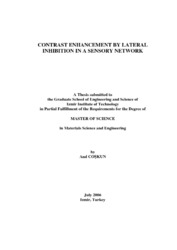Please use this identifier to cite or link to this item:
https://hdl.handle.net/11147/3218Full metadata record
| DC Field | Value | Language |
|---|---|---|
| dc.contributor.advisor | Özdemir, Serhan | - |
| dc.contributor.author | Coşkun, Anıl | - |
| dc.date.accessioned | 2014-07-22T13:51:06Z | - |
| dc.date.available | 2014-07-22T13:51:06Z | - |
| dc.date.issued | 2006 | - |
| dc.identifier.uri | http://hdl.handle.net/11147/3218 | - |
| dc.description | Thesis (Master)--Izmir Institute of Technology, Materials Science and Engineering, Izmir, 2006 | en_US |
| dc.description | Includes bibliographical references (leaves: 66-69) | en_US |
| dc.description | Text in English; Abstract: Turkish and English | en_US |
| dc.description | x, 78 leaves | en_US |
| dc.description.abstract | The most important mechanism to occur in biological distributed sensory networks (DSNs) is called "Lateral Inhibition, (L.I.)". L.I. relies on one simple principle. Each sensor strives to suppress its neighbors in proportion to its own excitation. L.I. is found all around the human nervous and sensory system. In audition, for example lateral inhibition occurs at the relay points on the way up to the brain. It is realized that L.I. must not be limited to biosystems. Any artificial system claiming to have a discriminating tactile sensing, say like a robotic hand, ought to carry a redundancy reduction and contrast enhancement tool similar to L.I.In this study, lateral inhibition mechanism was analyzed and simulated.To simulate the LI. mechanism an experimental set-up was built up.The effects of LI. mechanism were observed in an artificial sensory network that contained photodiodes.The sensors in the networks were stimulated by a halogen light source that can be moved in three axes.The results showed that LI. is not only functional for biological DSNs but also for artificial DSNs.LI. mechanism was also used to localize an unknown position of light source that illuminated the photosensitive sensory network containing high and low quality sensors. Each photosensitive sensor was calibrated relative to the distance to the light source. The output of each sensor was converted into a distance reading according to the calibration and this was employed to localize the position of the light source. Results showed that lateral inhibition mechanism increased the sensitivity of localization and it gave an ability to low quality sensors to make localization as sensitive as high quality sensors. | en_US |
| dc.language.iso | en | en_US |
| dc.publisher | Izmir Institute of Technology | en_US |
| dc.rights | info:eu-repo/semantics/openAccess | en_US |
| dc.subject | Lateral inhibition | en_US |
| dc.subject | Horseshoe crab | en_US |
| dc.subject.lcc | TK8312 .C83 2006 | en |
| dc.subject.lcsh | Photodiodes | en |
| dc.subject.lcsh | Nervous system--Mathematical models | en |
| dc.title | Contrast Enhancement by Lateral Inhibition in a Sensory Network | en_US |
| dc.type | Master Thesis | en_US |
| dc.institutionauthor | Coşkun, Anıl | - |
| dc.department | Thesis (Master)--İzmir Institute of Technology, Materials Science and Engineering | en_US |
| dc.relation.publicationcategory | Tez | en_US |
| dc.identifier.wosquality | N/A | - |
| dc.identifier.scopusquality | N/A | - |
| item.cerifentitytype | Publications | - |
| item.openairecristype | http://purl.org/coar/resource_type/c_18cf | - |
| item.openairetype | Master Thesis | - |
| item.fulltext | With Fulltext | - |
| item.grantfulltext | open | - |
| item.languageiso639-1 | en | - |
| Appears in Collections: | Master Degree / Yüksek Lisans Tezleri | |
Files in This Item:
| File | Description | Size | Format | |
|---|---|---|---|---|
| T000533.pdf | MasterThesis | 8.65 MB | Adobe PDF |  View/Open |
CORE Recommender
Items in GCRIS Repository are protected by copyright, with all rights reserved, unless otherwise indicated.